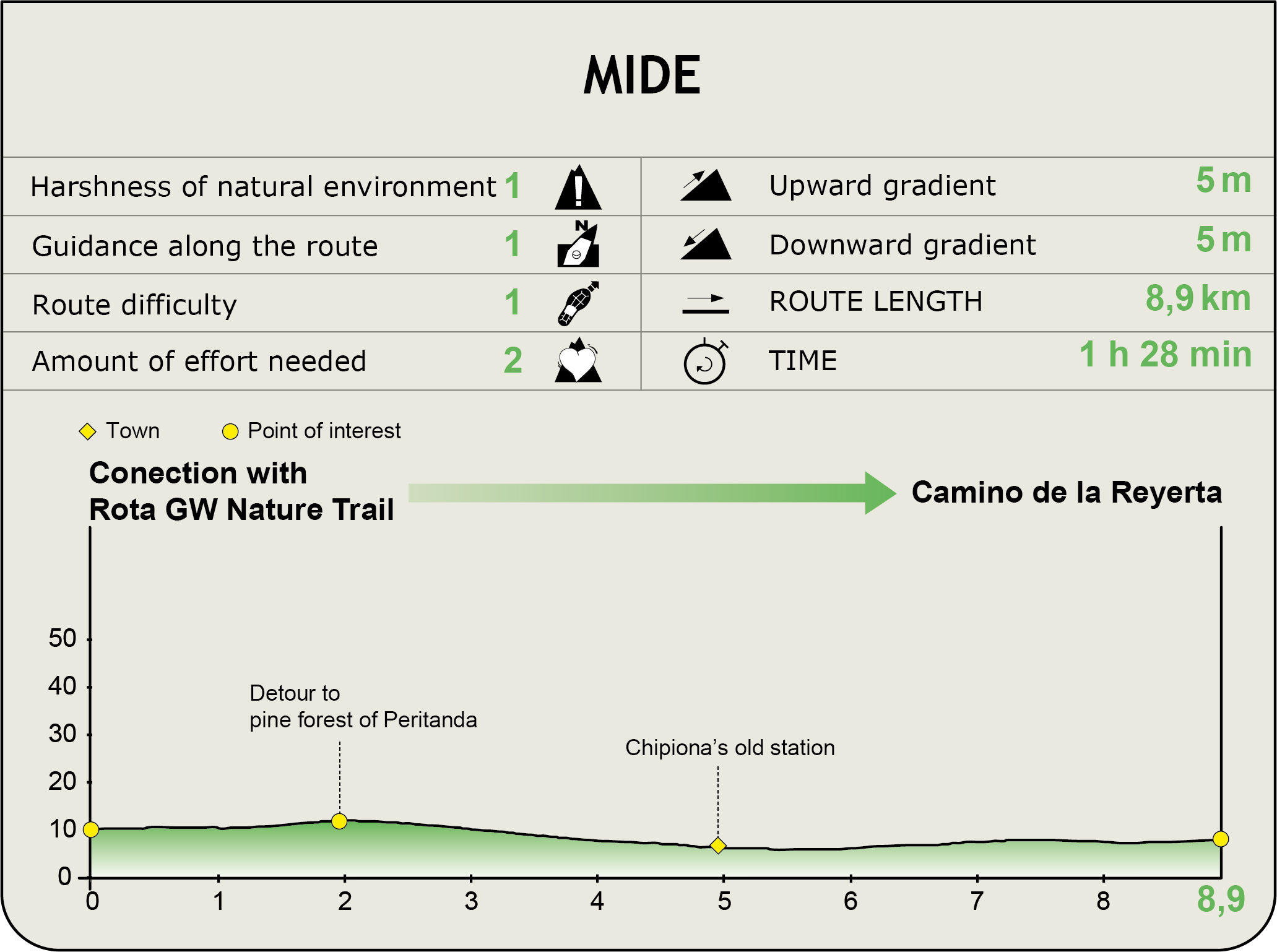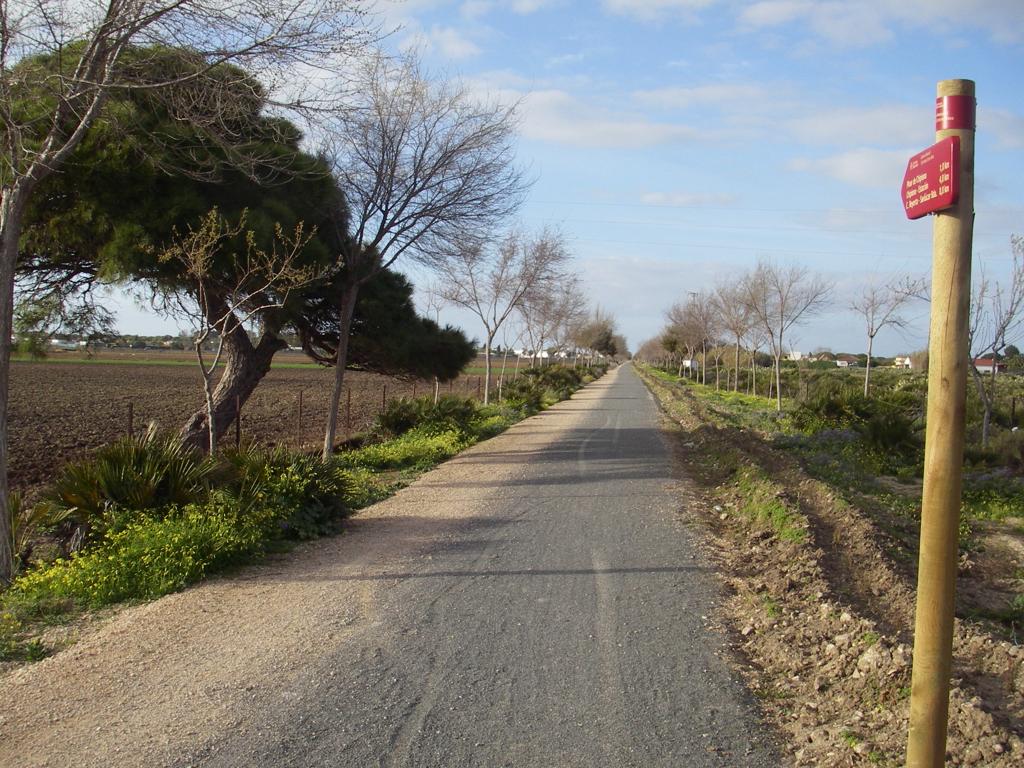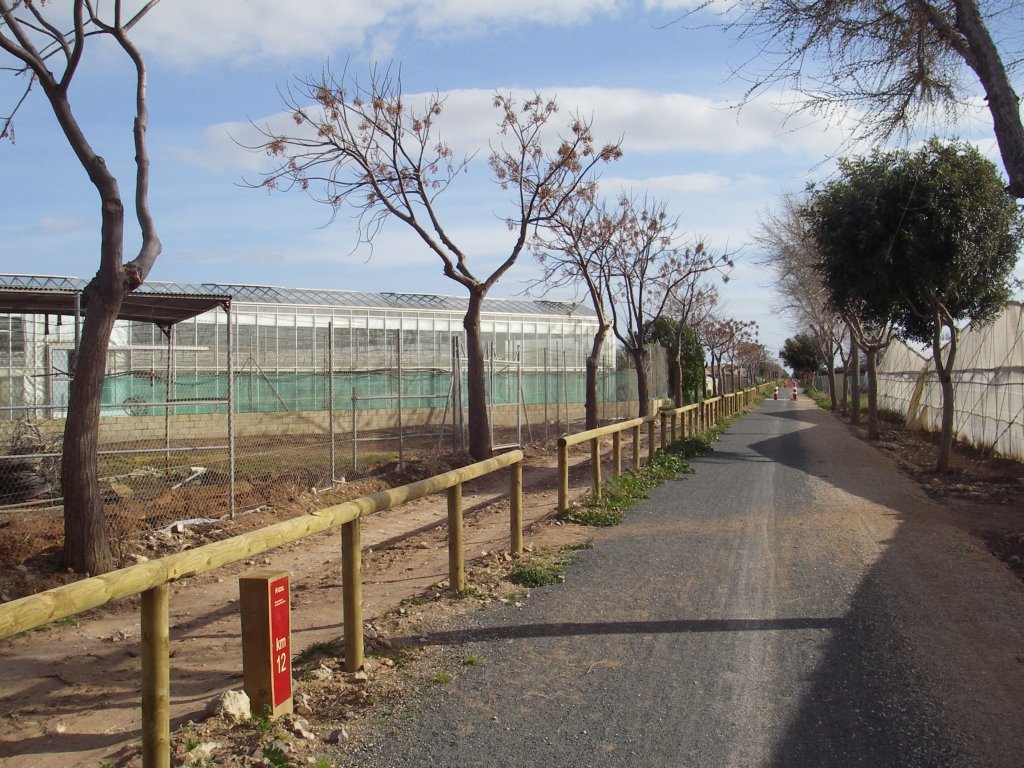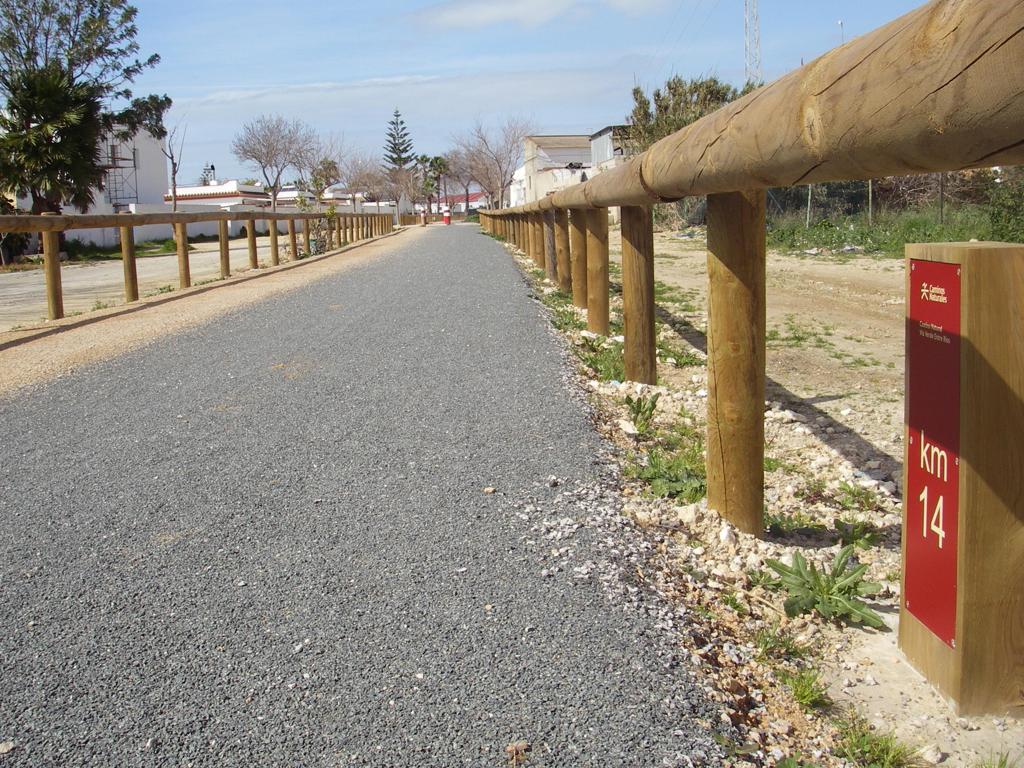- Home
- Rural Development
- Nature Trails
- Nature Trails
- South Sector
- Entre Ríos
Entre Ríos Greenway Nature Trail
Description

Following the "Tren de la Costa"
This Nature Trail runs along the old railway, popularly known as "Tren de la Costa", which linked El Puerto de Santa María and Sanlúcar de Barrameda. It was primarily built to transport sherry wine to the seaport for export to England. The origin and destination towns of the "Tren de la Costa" stand at the mouth of the River Guadalete (El Puerto de Santa María) and River Guadalquivir (Sanlúcar de Barrameda). This is the reason why the trail is called "Entre Ríos" (Between Rivers).

The landscape along this 9-kilometre route from Chipiona, on the boundary with Rota, to Sanlúcar de Barrameda, is predominantly agricultural, with many horticultural and cut flower greenhouses, mainstays of the local economy, as well as less-intensive crops. One can also enjoy the coastal ecosystem of pine forests, which help stabilise the shifting dunes, and increase and maintain the scarce water resources.
The Nature Trail starts at the same point as the Rota Nature Trail, which can be reached by taking a small slip road opposite the Costa Ballena housing estate, at Km 4 of the A-491. The Trail begins on a gravel road suitable for walking and cycling. Access points are delimited with bollards to prevent the entry of motorised vehicles.
The first stretch of Trail traverses through large irrigated croplands and small vineyards, with a predominantly agricultural landscape. It is likely one can see Common Hoopoes (Upupa epops), European Goldfinches (Carduelis carduelis), Common Stonechats (Saxicola torquatus) and Common Kestrels (Falco tinnunculus).
Past the intersection with the road to Venta del Montalbán, properly signposted like all intersections along the Trail, a row of prickly pear cacti (Opuntia maxima) and giant reeds (Arundo donax) appears to the right of the route signalling the presence of Majadales Creek. The route continues amidst crops and scrubland populated with Mediterranean fan palms (Chamaerops humilis) and prickly pear cacti, which bring colour in spring to this landscape of wild herbs.
Under the shade of the trees that flank the road, the route leaves the municipal nursery and El Pinar Training School by the wayside. From here, the Nature Trail runs parallel to a dirt road closed to motorised vehicles, other than those servicing the farms and houses along the route.

Scattered stone pine trees (Pinus pinea) begin to appear, almost like a preface to the notable Pinar de Peritanda, a pine forest that the traveller will see later in its fullness. It is worth taking a small detour at Colada de Chapitel intersection, crossing the bridge over Barrancón Creek to enjoy this remarkable setting in which a single-species pine forest and its undergrowth are home to typical Mediterranean forest species, including wild olive trees (Olea europaea var. sylvestris), kermes oaks (Quercus coccifera), myrtle (Myrtus communis), Mediterranean fan palm, lentisc (Pistacia lentiscus), rosemary (Rosmarinus officinalis), Spanish lavender (Lavandula stoechas) and bridal veil broom (Retama monosperma), and a variety of herbaceous annual species, including Asphodelus (Asphodelus sp.), which brings colour to this rich ecosystem.
This environment also plays host to a variety of animal species, including rabbits (Oryctolagus cuniculus) and Garden Dormouse (Eliomys quercinus), as well as birds like the Eurasian Blackcap (Sylvia atricapilla), Sardinian Warbler (Sylvia melanocephala), Chaffinch (Fringilla coelebs), European Greenfinch (Carduelis chloris), European Robin (Erithacus rubecula), Black Kite (Milvus migrans) and Common Scops-owl (Otus scops).

Several reptile species also thrive in this environment, including Ocellated Lizards (Timon lepidus), Ladder Snakes (Rhinechis scalaris) and the indigenous Common Chameleon (Chamaeleo Chamaeleon), listed as a species of special interest, and whose characteristics are explained in detail at "El Camaleón" Nature and Coast Interpretation Centre, located in the coastal area established under the La Laguna de Chipiona Development Plan.
The Shrine of the Virgen de Regla is located in this pine forest. The Pilgrimage of the Pinar, honouring Our Lady, takes place every first Sunday of June since 1948. A cart pulled by oxen, accompanied by horse-drawn coaches, horseback riders and pilgrims, brings the image of the Virgen de Regla del Pinar here from her sanctuary in Chipiona, where she was taken three days earlier. There are many recreational areas with benches in this beautiful setting, where one can rest before returning to the Nature Trail, which now ventures into an area changed by human activity, with many houses flanking the road.

Past another intersection, the landscape changes yet again when the route traverses through intensive croplands and greenhouses. After walking barely 1 kilometre from Colada de Puerto Romero on a long straight path, the railroad mileposts scattered along the road take the traveller back to the days when trains loaded with sherry wine, the sweet blood of this land that produced so much wealth, was exported to English markets. Indeed, Chipiona's Muscatel Museum promotes greater understanding of the ancient history and culture of these wines. It also sponsors the Muscatel Festival in late July and early August.
Heading down a long straight stretch between fields of crop, interrupted only by another signposted intersection, the route arrives at Estación Avenue with an information panel on Chipiona and the improvements made to this Nature Trail. Leaving the road behind, the route ventures into Chipiona. After crossing the roundabout via a pedestrian crossing, the Trail arrives at the old Chipiona railroad station (Km 14), one of few railroad structures that remain to this day, converted into a private home. About 300 m further on, the route reaches Granada Avenue. Caution should be exercised when using the pedestrian crossing to the right. The roundabout is topped with a replica of Nuestra Señora de Regla, patroness of seafarers, for whom the local people feel great devotion.

After crossing the road, the route continues along the railway platform, wedged between greenhouses, private homes and small market gardens. About 400 m further on, a bike lane and the Nature Trail overlap for a short stretch, until it reaches a pedestrian crossing on the street from the port, leading to Camino de Granadillos. Costa Grajuela is visible from here, with Punta del Guapo and the marina in the background. Next to the marina is the traditional Corrales de Pesca, artificial enclosures made with oyster stone in a rocky intertidal zone. A huge fishing trap uses tidal drift to capture fish.
Leaving the road to Granadillos to the right, the route continues straight ahead along a path delimited by a wooden railing. About 250 m further on, next to the gate of the San José farmstead, and at the intersection with the road to Ventisquero, there is a narrow paved path about 50 m long, where caution must be exercised as it is also used by motorised vehicles. Past this point, the route continues through market gardens, vineyards, fruit orchards, irrigated crop fields (potatoes, carrots, onions, etc.), horticultural greenhouses and a few cut flower glasshouses, primarily carnation. The latter is a very important sector for the local economy. Chipiona was a major exporter to Central Europe. Currently, only a few greenhouses from the heydays are still in operation. Although Chipiona remains the largest domestic producer of cut flowers, the export market is practically non-existent.
The path confined by railings ends immediately before the next intersection, about 1.2 km from the endpoint of this Section. In the last kilometre, the route passes between private homes, wasteland, and an occasional abandoned greenhouse until it reaches Camino de la Reyerta (Km 18), the endpoint of this Section of the Entre Ríos Nature Trail.
Profile

MIDE (Method for the Information of Excursions)
Featured
Further information
Chipiona's Lighthouse
Located at Punta del Perro, Chipiona's lighthouse dominates the landscape. This lighthouse, at a lofty 69 metres, is the tallest in Spain and the third in Europe. It was built between 1863 and 1867 by the civil engineer Jaime Font Escolá using oyster stone from Chipiona and Rota, stone slabs from Tarifa, and other materials from Sierra Carbonera (north of Gibraltar).
The slender tower, inspired by Roman commemorative columns, has 322 steps. The light-room at the top was originally equipped with an olive oil lamp. Today, a halogen lamp emits a light beam that can be seen 25 nautical miles away.
Chipiona's Lighthouse was designated an aeronautical and maritime lighthouse in 1963. It displays its horizontal and vertical beams every 10 seconds, providing navigational aid to both sea vessels and aircrafts.
"Tren de la Costa"
To better understand the history of this railroad between El Puerto de Santa María, Rota, Chipiona and Sanlúcar de Barrameda one must go back to 1876, when the construction work of the so-called "Tren de la Costa" or "Tren de Rota" began. The work lasted 16 years, until 1898, when it was completed.
The Compañía Belga de Ferrocarriles Vecinales de Andalucía, the licensee for building and operating the line, opened the 28.8-kilometre section between El Puerto de Santa María and Chipiona on November 17, 1892. The train consisted of an engine and three carriages (two for passengers and one for freight). It was equipped with an oil-based lighting system, and reached an average speed of 20 km/h. Years later, on June 19, 1898, the same company opened the second 8-kilometre section between Chipiona and Sanlúcar de Barrameda.
The line between El Puerto-Sanlúcar-Bonanza was subsequently operated by the Compañía de Ferrocarriles Andaluces until 1936, when the company was expropriated by the state owing to its economic deficit. After the Spanish Civil War, when RENFE was created, the "Tren de la Costa" was operated by this company until 1984. The last train travelled from El Puerto de Santa María to Sanlúcar on December 31, 1984, when the line was closed, owing to low profitability, problems with the staff and decline in the use of this train.







